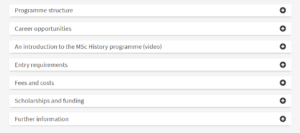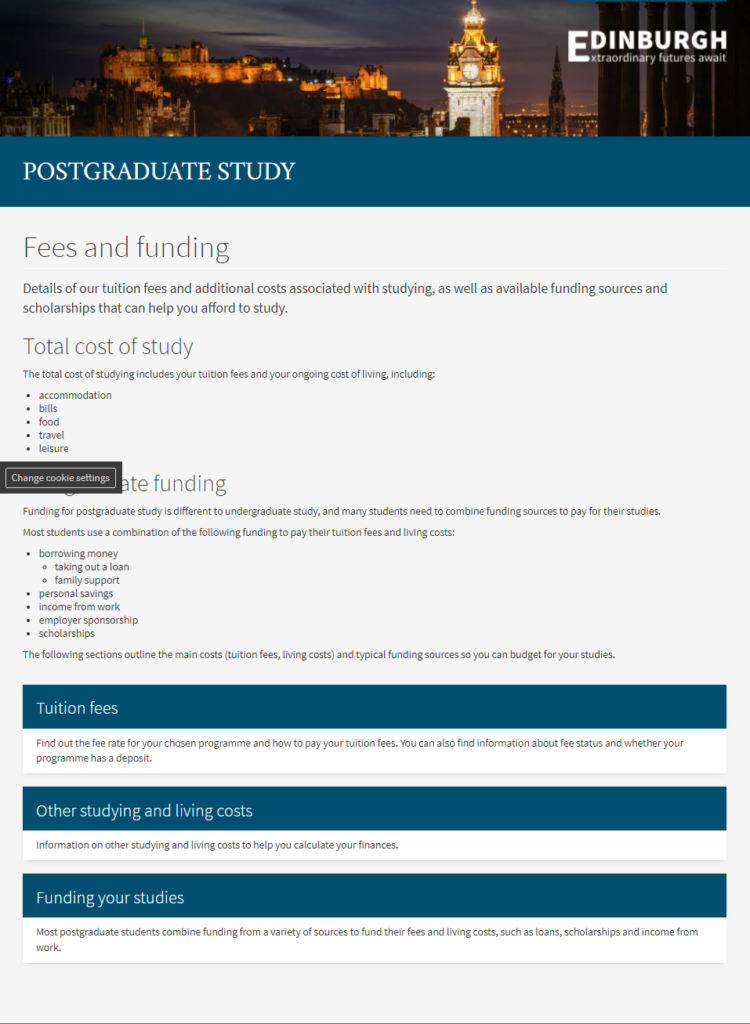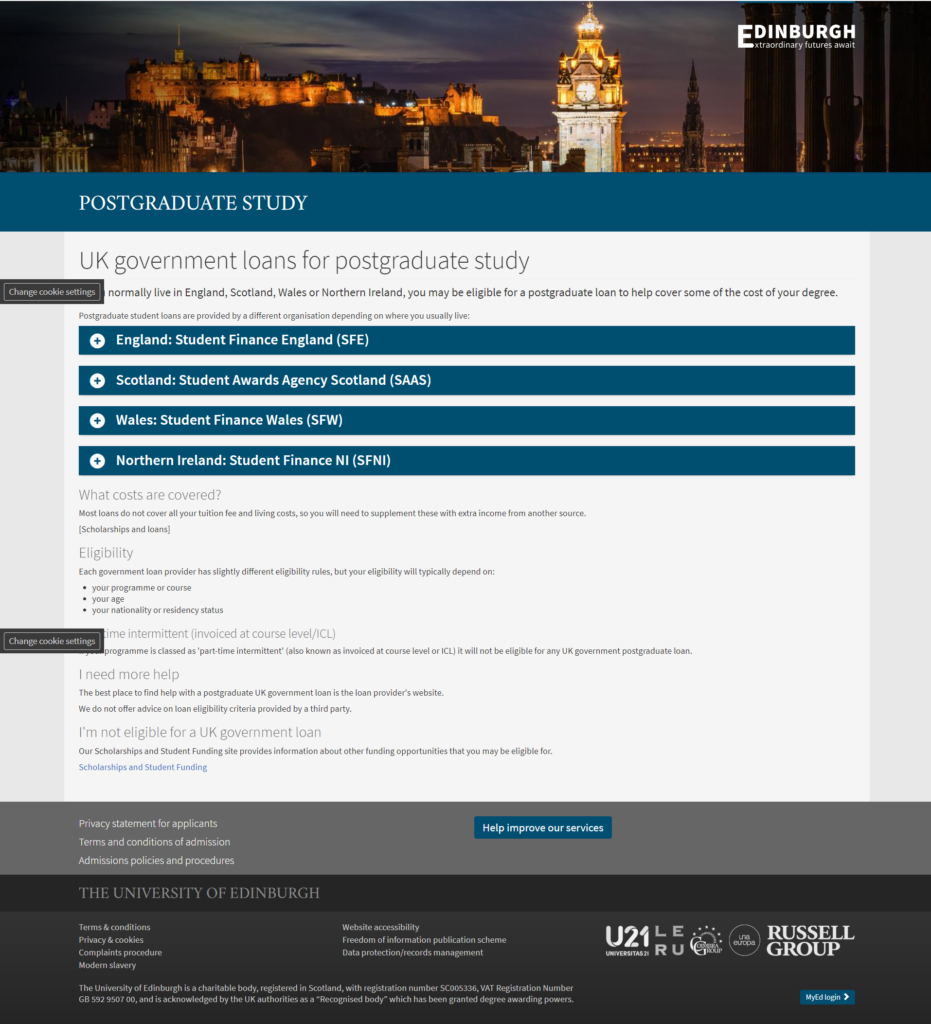Right information, right place: Channel mapping and content drafting
This blog is part of a series on a mini-project the Content Operations team completed in August and September 2024. In this instalment, we talk about channel mapping and drafting for our postgraduate loans content, taking our research and shaping it into workable content we could share and test.
For more information on the other stages, see our individual blogs:
- Improving student understanding of postgraduate funding and UK government loans: a Content Operations mini-project
- Defining the scope: Background, research and user needs
- Lessons learned from usability testing under time pressure
Mapping and drafting the content
Once we had our background, research and user needs, it was time to plan our new and repurposed content.
Part of this was ‘Channel and journey mapping’ – following the prospective student on their likely route to this information.
Postgraduate programme pages on the degree finder
Our analytics show that large numbers of prospective students start with the programme(s) they’re interested in. This means they’re often entering our sites through the degree finder. We would therefore need to address this point in the journey, as well as finding a suitable home for any more expansive content about typical sources of funding and UK postgraduate loans.
Channel-specific quirks
On this ‘channel’, our information would be competing with a lot of other information such as programme descriptions, structure, applying information and more. We therefore decided to add a short, generic ‘introduction to funding’ blurb that we could integrate onto every existing degree finder entry so we could:
- plant the seed about how postgraduate funding often requires multiple income sources
- provide a call to action prompting people to investigate these sources through a more developed section of content hosted elsewhere on the site
We did worry we might come across examples where the generic blurb didn’t work (spoiler alert: we did) but we tested a range of examples and did our best to avoid clashes.
We were also able to repurpose an existing accordion section called ‘Scholarships and funding’ that lent itself to adding this content. Ideally, we’d have changed the name of that section, but we were limited in what we could do in the time and without the input of a systems representative.

Louis worked on the first draft, and after a few versions we were ready to test it:
The first draft
Funding for postgraduate study is different to undergraduate study, and many students need to combine funding sources to pay for their studies.
Most students use a combination of the following funding to pay their tuition fees and living costs:
- borrowing money
- taking out a loan
- family support
- personal savings
- income from work
- employer sponsorship
- scholarships
Find out more about the different sources of funding available:
Postgraduate fees and funding section
Our second channel involved repurposing and expanding an existing section sitting in the Postgraduate site on fees and funding.
We knew from our research that our existing content was skewed towards scholarships, so decided instead to plot a new information architecture where loans content could sit prominently alongside scholarships.
Our first draft was a good start, but had too much descriptive content on what was effectively a portal page. We knew we needed to split out ‘funding your studies’ into its own area to explain the combination funding model, rather than trying to cram it onto one page.

Loans
This, and the UK government postgraduate loans content, was where we spent most of our time. However, we did try to future-proof things; UK government loans are not the only ones relevant to our international pool of prospective students, so we were keen to build with that in mind.
I didn’t think this was too contentious, but during some feedback sessions just before go-live I was cautioned to ‘design for what you have’, especially if you don’t know when you’re going to fill in the gaps. We did take this on board, but we were aware more work would be hot on the heels of this project, so we decided to lay the foundations for the larger scheme in the hope of staving off more complicated redesigns in the future.
UK government postgraduate loans
We used subsections on this page based on the relevant loan provider for each home country: Scotland, England, Wales and Northern Ireland. We then put this region-specific content in its own accordion, allowing the user to:
- Take in the headings at-a-glance alongside the overview (which applies to all sections)
- Choose to show/hide only the section that is relevant
- Reduce the need for subpages repeating the same overview information each time to factor in for users coming direct from search engines
- General eligibility and ineligible programmes (you can’t get a loan for every programme, and sometimes the type of programme you can get funding for differs depending where you live)
- What to do if you need more help
- Where to look for other funding opportunities if you aren’t eligible for a UK government loan
- A blurb and link for the degree finder
- Fees and funding section (existing; some changes)
- Tuition fees (existing; unchanged)
- Other studying and living costs (existing; unchanged)
- Funding your studies (replacing ‘Scholarships and loans)
- Loans (new)
- UK government postgraduate loans (new)
- Scholarships (updated)
- Other sources of funding (new)
- Are they doing the work to make something happen? (responsible)
- Are they ensuring the task is completed/marked as complete? (accountable)
- Do we need their opinion and/or do they have a stake in the task? (consulted)
- Do they just need to know it’s happening or has finished? (informed)
This method follows the UK Government’s design system advice on how to use accordions. Accordions hide information by default, so for our purposes this worked well: we wanted to hide information that wasn’t applicable, such as Scottish loans info for a prospective student residing in England. It’s not the only way we could have achieved it, but it seemed the cleanest.
GOV.UK Design System guidance on when to use accordions
The main content we wanted to cover was:

Scholarships
During our research phase, we identified scholarships information as being out of scope, so we didn’t do much to the existing content. However, we did find ways to streamline it as the original content was a little unfocused.
We also wanted to emphasise again that scholarships don’t always cover the full cost of study (even if you do manage to get one), as often they just cover tuition fees, not living costs.
The eventual draft was more concise and direct, while still serving as an introduction to the wealth of scholarship information across the rest of the website.
Other sources of funding
This was our catch-all section pulling together everything else in the funding picture: income from work, alumni discount, grants, and employer sponsorship.
Due to time constraints and the focus on UK government postgraduate loans, this section was still light on detail, but we needed a place to draw these areas together to fully explain the funding picture to prospective students.
Again, this is an area we identified as ripe for future improvement, particularly around working while studying.
Final drafts
This drafting work left us with a new structure and content for testing:
Stakeholder engagement
As the degree finder blurb was small, we popped it in an email to stakeholders to seek some feedback. But we held off previewing the bigger chunks until we had done a round of testing; we didn’t want to clutter inboxes with lots of drafts.
Determining the right level of stakeholder comms required a bit of a ‘see how you go’ approach. Depending on seniority and investment, you might find some stakeholders are regularly in contact (for their opinions as subject matter experts, for example), while others are on a need-to-know basis only (for awareness).
This sort of maps onto a RACI matrix – Responsible, Accountable, Consulted and Informed. You can put each of your stakeholders into these categories:
From this, determine how much you need to be in contact with them (daily, regularly throughout project, or only when moving between phases). We didn’t document this formally but for a larger project this kind of planning would be very helpful.
Testing
Drafts in hand, it was time to move onto testing.
More information on the approach to testing and the successes and lessons learned can be found in the next instalment:



